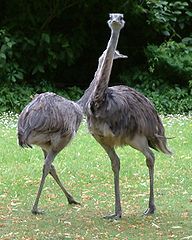Nandu
| Rheiformes[1] | |||
| Forbes, 1884 | |||
 Przedstawiciele rodziny – nandu szare (Rhea americana) | |||
| Systematyka | |||
| Domena | |||
|---|---|---|---|
| Królestwo | |||
| Typ | |||
| Podtyp | |||
| Gromada | |||
| Podgromada | |||
| Infragromada | |||
| Rząd |
nandu | ||
| Typ nomenklatoryczny | |||
|
Rhea Brisson, 1760 | |||
| Rodziny | |||
|
| |||
Nandu[3], strusie amerykańskie, strusie pampasowe[4] – rząd (Rheiformes) i rodzina (Rheidae) ptaków z podgromady ptaków nowoczesnych Neornithes.
Zasięg występowania[edytuj | edytuj kod]
Rodzina obejmuje nielotne gatunki lądowe, zamieszkujące Amerykę Południową[5].
Morfologia[edytuj | edytuj kod]
Są to szybko biegające nieloty o stosunkowo długich skrzydłach. Długość ciała 92–140 cm, masa ciała 15–25 kg (wyjątkowo do 40 kg[6])[7]. Ciało o jajowatym kształcie, z poziomą postawą. Głowa jest mała; dziób krótki, szeroki i płaski; długa szyja. Długie nogi mają trzy palce. Pióra bez zwartych chorągiewek, brak sterówek; dolna część szyi i górna nóg upierzona; upierzenie szare i brązowe, miękkie i swobodne[6]. Pokrojem przypominają strusie, są jednak od nich mniejsze.
Ekologia[edytuj | edytuj kod]
Nandu zamieszkują otwarte, zwykle suche siedliska, w tym łąki, zarówno na małych, jak i dużych wysokościach, tropikalne sawanny i otwarte lasy[6].
Odżywiają się pokarmem mieszanym, w którego skład wchodzi szeroka gama roślin i zwierząt: owoce, orzechy, nasionami, liśćmi, stawonogami i małymi kręgowcami, w tym ssakami, gadami i rybami[6].
Nandu są poligynandromiczne. Samce budują gniazdo, szorstkie zagłębienie w ziemi, które często pokryte jest wysuszoną roślinnością, i wydzielają haremy samic z większych grup społecznych, kojarząc się z nimi w pobliżu gniazda, aż do zakończenia dużego lęgu[6]. Pojedyncze samice składają do 14 jaj, a gniazdo jednego samca może zawierać do 60 jaj[6]. Samice często podróżują w grupach od haremu jednego samca do innego[6]. Samiec sam wysiaduje jaja przez 35 do 40 dni i zapewnia opiekę rodzicielską[6]. Po kilku dniach pisklęta opuszczają gniazdo wraz z samcem i mogą pozostać z nim przez co najmniej sześć miesięcy, ale często dłużej, odchodząc dopiero po osiągnięciu dojrzałości płciowej w wieku trzech lat[6].
Systematyka[edytuj | edytuj kod]
Badania przeprowadzone na początku XX wieku wykazały, że Rheidae są taksonem siostrzanym w stosunku do wszystkich innych Palaeognathae z wyjątkiem Struthioniformes[8][9][10].
Podział systematyczny[edytuj | edytuj kod]
Do rodziny należy jeden występujący współcześnie rodzaj[3]:
oraz rodzaje wymarłe:
- Heterorhea Rovereto, 1914[12]
- Hinasuri Tambussi, 1995[13]
Status populacji[edytuj | edytuj kod]
Obydwa występujące współcześnie gatunki z rodzaju Rhea, R. americana i R. pennata odnotowały gwałtowny spadek populacji na całym swoim zasięgu występowania, z powodu polowań, wybierania jaj z gniazd oraz niszczenia i zmian ich siedlisk[6].
Przypisy[edytuj | edytuj kod]
- ↑ Rheiformes, [w:] Integrated Taxonomic Information System (ang.).
- ↑ Rheidae, [w:] Integrated Taxonomic Information System [dostęp 2010-11-01] (ang.).
- ↑ a b Systematyka i nazwy polskie za: P. Mielczarek & M. Kuziemko: Rząd: Rheiformes Forbes, 1884 – nandu (wersja: 2015-02-09). [w:] Kompletna lista ptaków świata [on-line]. Instytut Nauk o Środowisku Uniwersytetu Jagiellońskiego. [dostęp 2020-08-150].
- ↑ P. Busse (red.), Z. Czarnecki, A. Dyrcz, M. Gromadzki, R. Hołyński, A. Kowalska-Dyrcz, J. Machalska, S. Manikowski, B. Olech: Ptaki. T. II. Warszawa: Wiedza Powszechna, 1991, s. 240, seria: Mały słownik zoologiczny. ISBN 83-214-0563-0.
- ↑ F. Gill & D. Donsker: Ratites: Ostrich to Tinamous. IOC World Bird List: Version 7.1. [dostęp 2017-03-20]. (ang.).
- ↑ a b c d e f g h i j D.W. Winkler, S.M. Billerman & I.J. Lovette: Rheas (Rheidae), version 1.0. W: S.M. Billerman, B.K. Keeney, P.G. Rodewald & T.S. Schulenberg (redaktorzy): Birds of the World. Ithaca, NY: Cornell Lab of Ornithology, 2021. DOI: 10.2173/bow.rheida1.01. [dostęp 2022-01-04]. (ang.).

- ↑ A. Folch: Family Rheidae (Rheas). W: J. del Hoyo, A. Elliott & J. Sargatal: Handbook of the Birds of the World. Cz. 1: Ostrich to Ducks. Barcelona: Lynx Edicions, 1992, s. 84. ISBN 84-87334-10-5. (ang.).
- ↑ S.J. Hackett, R.T. Kimball, S. Reddy, R.C.K. Bowie, E.L. Braun, M.J. Braun, J.L. Chojnowski, W.A. Cox, K.-L. Han, J. Harshman, Ch.J. Huddleston, B.D. Marks, K.J. Miglia, W.S. Moore, F.H. Sheldon, D.W. Steadman, Ch.C. Witt & T. Yuri. A Phylogenomic Study of Birds Reveals Their Evolutionary History. „Science”. 320, s. 1763–1767, 2008. DOI: 10.1126/science.1157704. (ang.).
- ↑ J. Harshman, E.L. Braun, M.J. Braun, C.J. Huddleston, R.C. Bowie, J.L. Chojnowski, S.J. Hackett, K.L. Han, R.T. Kimball, B.D. Marks, K.J. Miglia, W.S. Moore, S. Reddy, F.H. Sheldon, D.W. Steadman, S.J. Steppan, C.C. Witt & T. Yuri. Phylogenomic evidence for multiple losses of flight in ratite birds. „Proceedings of the National Academy of Sciences”. 105 (36), s. 13462–13467, 2008. DOI: 10.1073/pnas.0803242105. (ang.).
- ↑ M.J. Phillips, G.C. Gibb, E.A. Crimp & D. Penny. Tinamous and moa flock together: mitochondrial genome sequence analysis reveals independent losses of flight among ratites. „Systematic Biology”. 59 (1), s. 90–107, 2010. DOI: 10.1093/sysbio/syp079. (ang.).
- ↑ Rhea, [w:] Integrated Taxonomic Information System [dostęp 2010-11-01] (ang.).
- ↑ Rovereto. Los Estratos Araucanos y sus fósiles. „Anales del Museo Nacional de Historia Natural de Buenos Aires”. 25, s. 160, 1914. (hiszp.).
- ↑ C.P. Tambussi. The fossil Rheiformes from Argentina. „Courier Forschungsinstitut Senckenberg”. 181, s. 124, 1995. (ang.).
